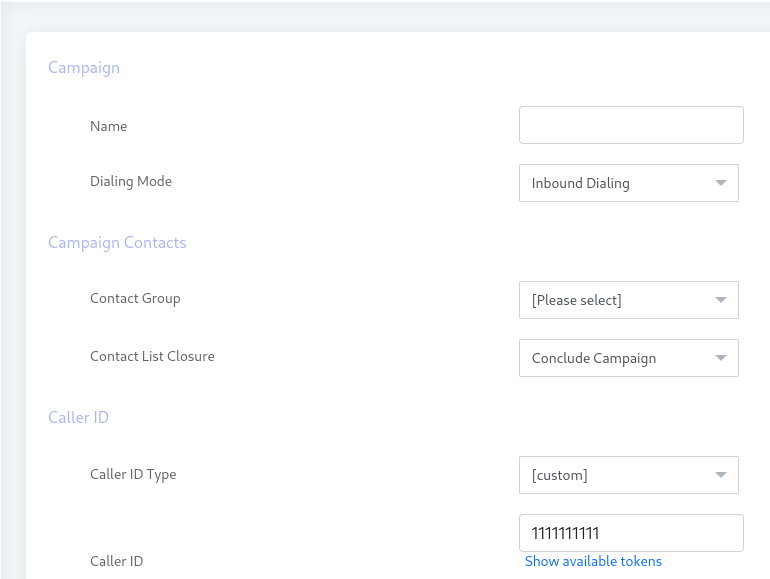ICTBroadcast, The Best Progressive Dialer Software
ICTBroadcast is a unified communications auto dialer software and call center software product that supports Voice, email, SMS, and Fax communication. It deployed open source asterisk communication software source at backend. There are multiple dialing modes available through ICTBroadcast, including Progressive dialing, Predictive dialing, smart Predictive dialing, Power dialing, preview dialing, IVR Dialing, Dynamic dialing and manual dialing using WebRTC web phones. Additionally, ICTBroadcast features an inbound & outbound call center software solution supporting a wide range of campaigns.
Asterisk-Based Auto Dialer Software
ICTBroadcast is a dialer, predictive dialer, progressive dialer, power dialer, and autodialer software developed using the open-source Asterisk communication engine and other open-source projects. The software uses the open-source Asterisk PBX for faxing and voice broadcasting, and the open-source Kannel SMS gateway for sending SMS messages. The Asterisk was developed by Mark Spencer in 1999. Asterisk PBX allows computers and phones attached to them to make and receive calls, as well as to connect to other telephone services including the Public Switched Telephone Network (PSTN) and Voice over Internet Protocol (VoIP). In addition to the open-source PBX and SMS gateway used by ICTBroadcast, there is also an open-source fax server and a fax receiver.
What is Progressive AutoDialer Software?
In a progressive auto dialer, the contact information is presented to the sales representative before the number is dialed. ICTBroadcast progressive auto dialer only dials the contact when the agent becomes available, places phone calls, and then automatically dials the next contact when the agent becomes available again. An agent-based personal communication system, rather than an automated or predictive system that places calls in a queue for multiple agents.
The Best Porgressive Dialer Software
ICTBroadcast is the best progressive dialer available in the market. The Progressive Dialer works in the same way as a Predictive Dialer by avoiding your agents manually dialing customer numbers. In any vertical, progressive dialers are used for customer service, sales, telemarketing, collections, or for as many other environments as they are required to dial outbound calls from a list while not burdening their call center agents with it.
How do Progressive Dialers Work?
The progressive dialing system reduces wasted time between calls by automatically dialing a number from a call list as soon as a representative becomes available. Progressive dialing systems, which make calls successively, but only when an agent is available, are fewer in number.
How to Create Progressive Campaign:
- Open the Navigation menu and select the main menu “Campaigns”.
- Select the sub menu “Campaign management” under main menu and click on it.
- Click on Add new button from top right side, page open then select the Agent Campaign from it.

- Now Enter the Required information in desired field such as Enter Campaign name, and select dialing mode as progressive dialing.
- Select the contact group and caller id
- Select the Agent to which campaign will assign and Agent campaign wrapup time out.


Note: In Progressive campaign when campaign run and agent select the dialing mode and campaign in agent panel then contacts list load and agent dial the contact automatically one by one after ending call. Progressive dialing makes fewer calls with predictive dialing, but it ensures that customers do not pick up calls without an agent to answer them. The result is more personal and productive interactions between your agents and your customers. Although progressive dialers are less efficient than predictive dialers, they still have the effect of greatly increasing the efficiency of your agents and enabling them to reach more clients than other technologies.
Preview Dialer
Telephone assistants can see all the details of the call before they pick up the phone, which saves them time. By using this great technique, the assistant decides whether he wishes to initiate the call or not.
Predictive dialer
Utilizes multiple techniques to minimize the amount of time that elapses between the time of dialing and the time of connecting a call to an agent. By using this technique, the phone agent can dial several phone numbers simultaneously. A predictive dialer gets in touch with an agent after the call is answered. In contrast, the messages played to the recipient when they answer the call are simple recordings or interactive voice response messages asking them to press a digit on their phone.
Difference between Preview, Progressive & Predictive Auto Dialer
As a Progressive Dialer, a single number per agent is dialed and the next number on the list is dialed once the agent’s current call is completed. As a result, Predictive Dialers dial multiple numbers for each agent, retrieving data from the call center to analyze the calls they make. Progressive dialing is therefore a very customer-friendly approach: the dialer enables an agent to be available as soon as the customer picks up the phone; it is unlikely that they will abandon calls. However, this approach also means that Progressive Dialers are less effective in terms of increasing agent productivity when compared to Power Dialers and Predictive Dialers. An agent typically needs to make three calls before getting one live call to call, because the average success rate of consumer outbound calls is 30% or less. 80% – 90% are answered in this mode typically for Business-to-Business calls. Activity with a progressive dialer is lower, when compared to Predictive and Power Dialers. In a preview dialer, advisors can see what’s next in the call list at the end of the call. During the call, they may be able to skip to the next name on the list and decide when to call. It is ideal for more complex sales where a little bit of research is required between the calls to increase chance of success.
Smart Predictive Dialer
A predictive dialer is similar to this, except the voice messages are not simple ones. As the recipient answers the call, the smart predictive dialer plays personalized messages based on custom variables, text-to-speech, and recorded messages. An intelligent predictive dialer connects the call to the agent by pressing some key on the recipient’s handset (typically key 1).
Power Dialer
Power Dialers, often referred to as Rapid Dialers, instantly dial a contact number once the call has been made. You don’t have to waste time looking up numbers on the phone when you make a call from a contact list with the power dialer. The power dialer switches to the next touch as soon as a number is unattended, busy, or disconnected.
IVR Dialer
It is an inbound communications based dialer, where customers dial published DID numbers and custom IVR plays, or the call is forwarded to agents for further communication, or the first IVR is played and they are asked to press desired DTMF to take certain action, such as pressing key 9, the call is forwarded to agents, An interactive voice response can include a simple message or it can be a multi-level message for conducting surveys, order booking, registration, appointments and other tasks.
Dynamic Dialer
Dynamic Dialer utilizes REST API to dynamically call a particular contact / lead directly from any CRM, Rest API automates business processes and it integrates any third party application / CRM with auto dialer seamlessly using REST API’s. Whenever the user or agent wants to place a call, he uses the REST API to reach out to said contact, the call is initiated and connected with an agent for further communication. We can also use the API dialer.
Click to Call Dialer
Using the Click to Call Dialer, agents/users of a CRM can simply click on any Lead/Contact for a call to be initiated. Since the dialer enables all telephone numbers / Leads within a CRM to be clickable, a call is initiated for communications and agents take the new call through WEBRTC based web phones.
Conclusion
We conclude that progressive dialer is an agent based auto dialer that waits for an agent to make calls. Progressive dialers call the numbers on a list with the help of an agent. If the agent is available, the dialers allow the call, but if the agent is not available, the dialers wait for the agent to make the call. As compared to predictive dialers and other dialers, progressive dialers dial contacts without agent availability.
